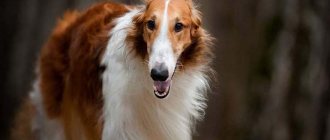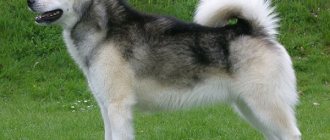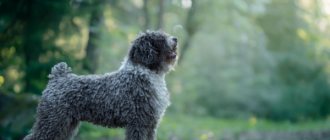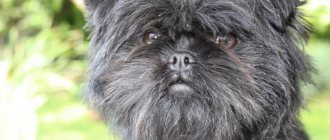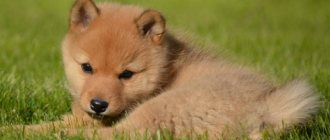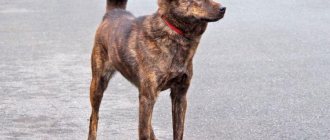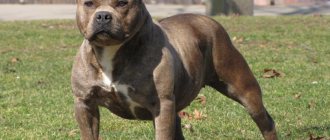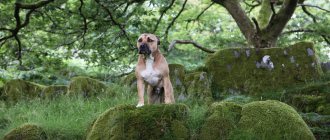Strong, brave, sensible working dogs - that's all Hovawarts, a dog breed that is not the most popular in the whole world. Quite common in its homeland - Germany. There is no doubt that Hovawart is a Molosser, but for a long time they did not want to officially recognize him, although the exterior is consistently transmitted.
The fact is that over the years of the breed’s formation, the exterior and preferred working skills were changed several times. Literally, the name of the breed means “guardian of the yard.” The breed group received its name in the 13th century.
Hovawart origin story
The first mention of the breed dates back to the 13th century, but the history of the breed has been lost for centuries. The group's origins probably occurred much earlier. There is evidence of Molossians accompanying tribes of warriors and hunters across the territory of modern Germany. Another version says that Hovawarts were bred for the “VIPs” of antiquity: the breed was bred for the aristocracy, falling into the hands of workers completely by accident.
An innate feature of all Hovawarts is the ability to act independently in difficult situations. This feature creates difficulties when raising a dog, but makes it unique.
Many centuries passed from the moment of the first mention to the recognition of the breed by official bodies: only in 1964 was registration made with the International Canine Federation. The dogs joined the Molosser group and section with mandatory working tests.
At the end of the 19th century, the Hovawarts almost disappeared, because in their homeland - in Germany - an “industrial boom” was raging, excluding other interests of citizens other than heavy industry. The breed was saved by father and son (Bertram and Kurt Koening), who founded their own nursery. When selecting breeders, the biologist and zoologist paid attention, first of all, to intelligence and character.
Curious! These days, the goal of breeding is to stabilize characteristics and improve conformation.
Shortly before World War II, the ideal male dog, Castor, was born. The manufacturer corresponded to the description of the breed today. He passed on excellent qualities to his offspring. The war and the post-war situation in Germany served to stop breeding work. It was possible to resume breeding only five years after the war.
The Hovawart is a rare breed these days; its breeding is monitored by the International Canine Federation and the International Hovawart Federation.
Today the Hovawart is a rare breed , but this is understandable. The breeding of the breed is monitored by both the International Canine Federation and the International Hovawart Federation. Only animals with full honey are allowed for breeding. examination to exclude the presence of hereditary diseases. Such a specimen, in addition, must absolutely comply with the breed standards.
History of the breed
The Hovawart dog was first bred in Germany. The exact time is unknown, but already in the chronicles of the thirteenth century a breed very similar to it is mentioned. It is believed that dog varieties such as the Newfoundland, Kuvasz and Leonberger were used for breeding.
True, they were recognized as an official separate breed only in 1932, and entered into the FCI register in 1955.
For reference! The name of the breed comes from the German phrase - hovawart, that is, “yard” and “guard”. From this it becomes clear that the term “Howard dog” is incorrect; there is no such breed.
Appearance, breed standard, photographs
When looking at photographs, the breed is often confused with others: either with Labradors, or with Mountain Dogs, or even less similar to “Howik” dogs. Meanwhile, Hovawart is distinguished by his appearance, character and skills.
The Hovawart is a strong, large, courageous, even-tempered working dog with long hair. The average weight of a Hovawart is 25-40 kg, its height is regulated by the following standards:
- for males it is 63-70 cm at the withers;
- in females – 58-65 cm.
Official breed standard
Dogs that do not meet the standards are not allowed for breeding:
- The head is wedge-shaped, rounded forehead, rosary transition to the bridge of the nose. The line of the muzzle is strictly parallel to the frontal line. There are no folds on the head, the cheekbones are developed, but do not contrast with the appearance. The “face” narrows slightly towards the nose, the lips are tightened and pigmented.
- The teeth are large, strong, and set evenly. The bite is strictly scissor. If the dog meets all the requirements and has no deficiencies, a straight bite is allowed.
- The nose is proportional to the muzzle and is mobile. The nostrils are well developed. The color of the lobe depends on the color of the fur - from light brown to black.
- The eyes are harmoniously located, medium in size, oval. The color depends on the coat, but brown shades predominate. With a fawn color, lightened eyes are acceptable.
- The ears are triangular, drooping, soft. Planted moderately deep and wide. At rest, the tips of the ears touch the line of the lips. When the animal becomes alert, the ears rise and turn forward.
- The body is elongated, 10-15% longer than it is tall (at the withers). The neck is medium, the scruff is not clearly defined. The chest is spacious, deep, and the muscles are well developed. The withers are pronounced, the back is level, strong, and long. The loin is elongated, the croup is sloping.
- Limbs . The front ones stand perpendicular to the ground, straight, parallel. Powerful shoulder blades are retracted to the back, shoulders are long, strong, wide, pressed. Elbows are pressed, directed back. The hind limbs stand vertical to the ground. The shins, thighs, and hock joints are located at clearly defined natural angles, the muscles of the limbs are well developed. The wrists are rounded and collected. The claws are dark; in light-colored animals, lightening is possible.
- The tail is lowered below the hocks and does not reach the ground. The edge is rich. The tail is strong and tapered. Carried low or with the saber bent towards the spine.
Coat type and color options
The Hovawart's coat consists of two layers: guard hair and a fairly developed undercoat. The coat is dense, slightly wavy, elastic, thick, semi-long. On the front of the limbs and muzzle, the guard hair is much denser and shorter.
The standard provides three color options: black, fawn and black and tan.
The standard provides three colors:
- black without marks or stains;
- rich fawn, lighter on the lower part of the sternum and belly. Lighter colored markings are acceptable;
- black and tan. The predominant color is black. Fawn markings in the form of a mask on the face, neck, eyebrows. Spots on the chest, shoulders, “socks” on the limbs, under the tail. With this color, white hairs on the tail and paws, and a spot on the chest are allowed.
Dossier
Height of an adult: females - 58-65 cm, males - 63-70 cm. Weight: females - 25-35 kg, males - 30-40 kg. Characteristic color: black, black with golden tan, fawn. Coat length: long. Life expectancy: 12-15 years. Advantages of the breed: loyal, intelligent, balanced, Difficulties of the breed: loves long walks, physical activity. Average price of a Hovawart: $1,000. Classification: medium breed, service, working, guard, driven, companion dog.
Character and temperament of Hovawarts
The Hovawart is a peaceful and friendly animal. Very often this breed is used not only for protection, but also as a therapist or assistant to the disabled. Hovawart is a leader and guardian.
Character virtues:
- Pronounced territorial behavior. In ancient times, dogs were used to guard yards.
- It is easy to train, but requires a fair amount of patience. This is due to later maturation relative to other breeds.
- Always confident in himself, endlessly loyal to his owner.
- Hovawart is calm and level-headed, despite his constant vigilance.
The dog is active and requires long walks.
Education and training
The effectiveness of training depends on the degree of trust between the trainer and the dog. If you have a friendly relationship with the animal, the training will quickly bear fruit.
The success of training depends on the relationship between the owner and the dog; if they are trusting, the Hovawart will gladly fulfill all the owner’s requests.
It is very important to socialize Hovawarts in a timely manner, since re-education will take a lot of effort and time, and it will not do without the intervention of specialists. It is necessary to instill in the dog the idea of family hierarchy.
For those new to keeping animals, it is worth asking for help from professionals to pass the OCD. After mastering this “science,” you should find a common hobby that will bring you closer to your dog and prevent it from getting bored, for example, agility.
Important! It must be remembered that the Hovawart is a service breed. This means that animals desperately need exercise and daily work.
You cannot “break” Hovawart’s character without allowing him to act on his own. Pets of this breed are very smart, they will not do something forbidden on purpose. If a problem appears, it is necessary to correct the behavior as gently as possible and as less noticeable to the dog as possible.
If the defense of the territory takes place in a harsh aggressive manner, you should take a ZKS course and teach the dog the FAS command. At the beginning of work, it is worth consulting with a trainer, asking him to evaluate the animal in real conditions.
You can take a ZKS course with Hovawarts, but before that the dog must be taught all the skills from the general training course.
Education and training
It is worth considering that the Hovawart matures relatively late. An adult dog may appear to have puppy-like behavior. Education should be patient and gentle; forceful methods can lead to the pet withdrawing into itself. This will make him unavailable for training. Very often, the Hovawart shows its guard qualities at an early age and often does not require special training to perform protective guard duty.
Hovawart obeys commands without losing his dignity, and always remains a friend, not a servant.
The Hovawart has an innate tendency to discipline, extraordinary mental abilities and high trainability. Thanks to these qualities, working with a dog is very easy. Hovawart will not set himself a goal - to dominate the family, but if he sees that the owner is not coping with the responsibility of the leader of the pack, he will try to take this position and then he will decide for himself exactly how to behave in various situations.
Hovawarts that are to be bred undergo working tests, they are checked for guard qualities and shooting.
Care and maintenance
It is not worth keeping dogs of this breed in an apartment, since the ability to patrol the territory is important for them. The same reason explains the ban on keeping them on a chain or in an enclosure. When purchasing such an animal for an apartment, you need to think about the fact that you will have to walk the pet every day for a long time and actively for the rest of their life, exhausting it with all your might.
You should care for your Hovawart's coat in the usual way: clean it weekly, comb it out during the shedding season, and bathe it when it gets dirty. Working animals do not need to have their nails trimmed, but they must be checked for chips and cracks.
Ears are cleaned several times a week, as needed. The ears fit tightly to the head, so otitis media often occurs, especially in summer. If you have a straight bite, you need to regularly clean your teeth and possibly remove plaque.
Hovawart dog. Description of the Hovawart breed. Hovawart.
Hovawart
DESCRIPTION . Height at the withers for a male is 65-70 cm, for a female - 60-65 cm. Weight is 30-40 kg. The head is wide and rounded. The forehead is wide, arched, the transition to the muzzle is well defined. The muzzle is of medium length, slightly pointed. The ears are drooping and set far apart. The chest is deep and spacious. The back is straight. The tail is long, thick at the base, and covered with fine hair. The coat is elongated, thick, silky, soft, lying in wavy strands. Color: black, black and tan, fawn (preferably with a black mask). STORY . Various manuscripts from the 13th century first mention a yard dog, distinguished from other breeds under the name "Hovewart" or "Hofwart", which translated from German means "guardian of the yard". It is likely that this type of dog existed much earlier. Be that as it may, she has always been valued as a guard dog and personal guard. Breeding of pure breeds began only at the beginning of the 20th century. In the Middle Ages, the Hovawart was kept mainly in rural areas as a guard dog. Hovawart was popular both among the peasants and the German aristocracy. Over time, dogs of this breed almost completely disappeared. Only after World War II did enthusiasts manage to find several individuals. To preserve the breed, they may have been given Leonberger and Newfoundland blood. Nowadays, the breed is successfully developing in Germany and Great Britain, and in 1990 it appeared in Russia. CHARACTERISTICS, CHARACTER AND USE . Hovawart is a man's faithful friend and companion. He is characterized by sociability, but does not tolerate a familiar attitude towards himself. Has an instant reaction and rapid movements. Amenable to training for guard and guard duty. Today, the Hovawart belongs to the classic guard breeds, is easy to train, and is also distinguished by its hard work and great affection. He has proven himself best as a police, guard and rescue dog, but when kept in a family, he can be used for various purposes. Being an affectionate and loyal companion, he loves to go on long walks with his owner. Achieves success in training to be an accompanying dog, suitable for security work and tracking work. As a reliable watchman, the Hovawart announces the approach of strangers with a loud bark, but otherwise behaves quite calmly. Hunting is perhaps the only activity for which he is not suitable, and the instinct of bullying, which manifests itself in him, like many other dogs, at a young age, can be eliminated with the help of certain educational measures. When breeding this breed, the main importance was attached not to a single appearance, but to the preservation of the characteristic physical qualities that distinguish the Hovawart as a utility dog. Hovawart - The name "Hovawart", meaning "castle guard", is found in German chronicles in the 13th century. WE doubted for a long time which of the mastiff groups this ancient German breed belongs to, since its origin is unclear, and its appearance and area of application have changed quite a lot throughout history. Its appearance bears similarities to the proto-Molossians from the group of European mountain shepherds, and in terms of temperament and trainability the dog is closer to the Rottweiler. In the foreign press, information about the origin of the breed is contradictory and sketchy, so there is no point in dwelling on this issue in detail. It may seem indisputable that the origin of the breed involved both the Proto-Molossians, who in ancient times came to the territory of Germany with the Ostrogoth tribes, and the Great Dane dogs of the Romans, who conquered the southwest of Germany by the 2nd century AD. It is generally accepted that the Hovawart was an elite breed, bred exclusively by feudal lords and aristocracy. This position is controversial, since similar breeds in other European countries accompanied shepherds and were common in peasant farmsteads. Most likely, the ancient Hovawarts were used as baiting dogs when hunting large animals and as guard and military dogs, accompanying their owners on campaigns and guarding the entrusted territory at night. As free peasants became enslaved and ruined in the 23rd century, the Hovawart really became the dog of those in power, but we should not forget that around the same time a similar process was happening with other large breeds (a poor farm laborer could not keep a large dog). The appearance of other breeds and changes in purpose during the late Middle Ages further narrowed the circle of breed breeders: the Hovawart was preserved only in old aristocratic families in the position of family watchman and bodyguard. Gradually, the Hovawart disappeared, was replaced by more fashionable dogs, and by the end of the 17th century it completely ceased to be mentioned in German chronicles. But fate decreed that after two centuries of oblivion, interest in this breed was revived. By the beginning of the 20th century, two small and isolated populations remained in Germany - in the Harz and the Black Forest. Kurt Konig, an enthusiast and connoisseur of the breed, found several dogs that corresponded to the old breed type in remote farms and farms in these regions. The restoration of the breed began with these producers. The theory of “restoration” of the Hovawart by hybridizing several breeds, which is very widespread in canine literature, seems frivolous. According to this theory, Kurt Konig and his friends crossed Hovawart-like farm dogs with Leonberger, German Shepherd, Newfoundland, Kuvasz and even a semi-wild pariah dog from the African veldt. The latter was allegedly used to give the offspring tirelessness and performance. If we assume such a scheme, then it should be borne in mind that at the beginning of the century the breed type of Leonberger and German Shepherd had not yet been fixed, therefore, in addition to the diversity of potential ancestors, their genetic instability must also be taken into account. Obviously, when crossing several unrelated, genetically unstable breeds, the result should have been a “vinaigrette”, from which it will not be possible to isolate the desired type soon, and this is in the presence of rich sponsors and the highest skill of breeders, and Kurt Konig bred the breeding core in less than two decades. By 1936, the population was stabilized, and a year later an official standard was created, at which time the breed was registered by the German Kennel Club. In 1960, associations of Hovawart lovers emerged in Sweden, Switzerland, Holland, Austria, Denmark, Finland and Scotland. The first representatives of the breed appeared in the USA and Canada in 1980. Now Hovawarts have appeared in Russia, so it is worthwhile to dwell in more detail on the properties of the breed and the features of breeding work with this wonderful dog abroad. Domestic fanciers should keep in mind that the Hovawart matures relatively late and retains the traits of puppy behavior for a long time. The breed needs patient and gentle upbringing, as forceful methods lead to the young dog becoming embittered and withdrawn into itself, becoming inaccessible to training. Bred for centuries as a watchman and bodyguard, the Hovawart exhibits watchdog tendencies at a very early age and often requires no further specialized training to serve as a guard and protector. High trainability and an innate tendency to discipline are combined with a very developed sense of self-esteem and strong will. These qualities require the owner to be able to gently subdue the dog and take the place of the “leader of the pack”, in its perception. This is especially true for owners of male dogs. If all these conditions are met, good care and regular exercise, the Hovawart will be an ideal family dog in any home. Let us separately dwell on the breeding of this breed. The approach to its selection in the West, thought out with German thoroughness, can serve as an example for any club and nursery. Manufacturers' quality requirements are very strict and relate to both the type, color and quality of the coat, as well as health and temperament. Mandatory fluoroscopy has resulted in a herd that is 95% free of hip dysplasia. All dogs are tested for “shot” and watchdog qualities, so individuals with atypical behavior are extremely rare in the breed. I would like our breeders to preserve the best breeding traditions in their work and ensure high quality Hovawarts in Russia. EXTRACTS FROM FCI STANDARD No. 190. General impression. Medium size, strong but not heavy. Unpretentious, works in any weather, distrustful, fast, self-confident, with a great sense of self-esteem. Temperament . Active, playful, loyal to his own and distrustful of strangers, inclined to dominate other dogs. Head and skull. Expressive head, wide in the skull, without wrinkles or folds. The length of the muzzle is equal to the length of the skull. Pronounced transition. The bridge of the nose is straight. Eyes. The eyelids are oval in shape, the eyes are preferably dark and of medium size. Calm, intelligent look. Ears. Triangular, medium or high set, hanging, covered with either long or short hair. Teeth. A scissor bite is preferred. A straight bite is acceptable, but not desirable. Neck. Strong, dry, medium length. Suspension is not allowed. Forelegs. Long, sloping shoulder, good angulation, strong, vertical forearms, slightly sloping, flexible pastern without signs of weakness. Well developed, lean muscles. Frame. Balanced, body length slightly greater than the height of the dog at the withers. Strong top with developed withers, straight back line, short croup, slightly sloping towards the tail. The chest is deep, the chest is long. The loin is strong and moderately deep. Hind limbs. Strong, muscular. Good angles. Metatarsus of medium length. Flexible, strong hock joints. The position is parallel. Paws. The front ones are oval, the rear ones are oval or hare. In a lump. Tail. Long, covered with thick hair, reaching below the hock but not reaching the ground when the dog is standing. When moving, it is held high and can be bent, but not curled into a ring or tipped to its side. Movements. Light, sweeping, free. Not loose, well coordinated. Wool. Long, short on the head and front legs. Color. Often fawn, darker along the line from the nose to the tip of the tail and gradually lighter on the sides below. With this color, a brown nose and light eyes are acceptable if they are darker than the color of the dog. A few white hairs on the chest and tip of the tail are acceptable. Black: Deep jet black without any extraneous tint. A white spot on the chest and tip of the tail is allowed. Height and weight. Male - 63-70 cm, weight 30-40 kg. Female – 58-65 cm, weight – 25-35 kg. Alexander INSHAKOV, Evgeny TSIGELNITSKY. Magazine "Friend" 1997, ZooMax - project of the publishing house "Friend" dog.adgth.ru/files/drug/hovawart_d.htm
Feeding Hovawart: the right diet
Hovawart is fed dry food of at least premium class.
The breed is not characterized by allergies, they are not prone to digestive disorders, which allows them to be quite flexible in their approach to feeding rules. Breeders advise feeding Hovawart with dry food, but this is only advice, not a condition. The food must be of high quality, balanced, containing all the necessary elements.
Foods suitable for Hovawart dogs:
- HAPPY DOG;
- Acana;
- Almo Nature Holistic Adult Dog Large;
- Barking Heads.
Health and life expectancy
On average, dogs of this breed live 13-15 years, which is quite long for large breeds. Thanks to selection, there are no breed diseases. Today, breeders are fighting for complete relief from the main ailments of large active dogs: hypothyroidism and pelvic joint dysplasia.
Viral diseases and parasites can affect Hovawarts, so it is very important to promptly vaccinate pets, carry out deworming and other preventive measures.
Choosing a puppy: what to look for
Choosing a puppy is a very responsible matter, because by buying it, we are acquiring not only a friend, but also a family member. Before purchasing a dog, you should visit several exhibitions: this way you can become familiar with the characteristics and standards of the breed.
Ideally, you should purchase a Hovawart puppy from a kennel. This way it will be possible to examine all the puppies, observe them, see their parents and evaluate their psyche.
When choosing a guard, you need to evaluate the reaction of the puppy's parents to a stranger. If they are friendly, this indicates a lack of fear in dogs. There is a high probability that the puppies will be the same, which will allow them to become excellent watchdogs. If an adult growls and hides, this is a bad indicator. The offspring of this animal will not be able to demonstrate protective qualities, but it is better to conduct additional tests.
Important! Healthy puppies can only be born from healthy parents. Before mating, it is necessary to identify possible diseases of the dog and the bitch. Their health status is confirmed by relevant certificates.
When examined, the puppy should be playful, cheerful, curious and mischievous. The eyes should be unclouded and clear. The ears should not smell, they should be clean. To choose the best puppy, you should take a specialist with you for an examination, who can confirm the excellent health of the dog.
These dogs are quite rare throughout the world, so their puppies are expensive. The average price for a not very thoroughbred representative starts at $1,000.
You should only purchase a Hovawart puppy from a trusted nursery.
In our country there are nurseries that breed the breed.
Moscow region:
- “Hovawart-ZobelsHof” https://hovawart-zobelshof.ru/contacts;
- "Hovawart" https://www.hovawart.su/.
Saint Petersburg:
- “Hof Harz” (“HOF GARC”) https://hovawart.ru/;
- https://proekt-chranitel.narod.ru/index/0-9.
In Yekaterinburg - “Hovawarts in the Urals https://hovawart-ural.ru/index.php?option=com_contact&Itemid=28.
It is strictly prohibited to sell dogs in countries that are not members of the International Hovawart Union.
How to choose a puppy
It is recommended to adopt a puppy at the age of 2-3 months. It is not recommended to bring an adult dog into your home. The puppy is purchased from a certified nursery or from a highly reputable breeder. The baby must have all the necessary documents:
- pedigree;
- puppy card (metric) with vaccination marks;
- copies of parents' diplomas and copies of their medical records.
When choosing, active, inquisitive, nimble kids are welcome. Your Hovawart puppy should not be afraid of you. It is worth looking at the parents of the little Hovawart to make a judgment about their behavior and character. The puppy must meet the breed standard:
- The head is powerful, with a round forehead. The brow ridges are not pronounced. Nose – black or to match the coat.
- The jaws are strong and have a scissor bite. Possible tick-like. Lips are dry, pressed against the teeth.
- The eyes are medium in size, oval in shape, with tightly closed eyelids. Color ranges from light brown to black.
- The high-set triangular ears hang on cartilages. In a state of tension - elevated.
- The neck is strong and of medium length. Not massive, well covered with hair.
- The body is strong and muscular. The length is 10-15% greater than the height.
- The chest is muscular, deep, with a tucked belly.
- The back is straight, the lower back is convex.
- Limbs – muscular, parallel, of medium length. The angles of the joints are clearly defined. The color of the claws corresponds to the color.
- The tail is long, descends to the hocks, and fluffy.
Reviews from Hovawart owners
Artem. The dog is beautiful and serious. I think it's too serious for beginners. Requires delicacy, but firmness. If you punish him, even for a reason, he may become offended and stay away all day. He loves to pick up all sorts of nasty things from the ground. If he notices something he needs, he doesn’t give a damn about orders and pretends to be deaf. The animal is already 9 months old, but behaves like a baby. An excellent companion, gets along well with children, loyal. But there’s a problem with training.
Daria. Yes, not an ordinary animal. But, in my opinion, it is worth any cost: both material and psychological. In general, I believe that training a working dog can only be done under the supervision of specially trained people. That’s why I entrusted my upbringing to professionals. Now I couldn’t be happier with the dog: obedient, functional, but at the same time still loyal and affectionate.
Michael. The dog is very interesting. We are waiting in line at one of our nurseries. Imported male, our mother. I really hope to get a great puppy. I would like to test it at work and attend exhibitions. I’m not new to dog breeding, so I expect to cope with Hovawart’s difficult temper. In a word, let's see who wins.
We invite you to watch a video about the rare Hovawart dog breed. We wish you pleasant viewing!

